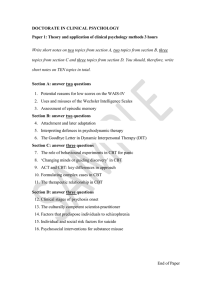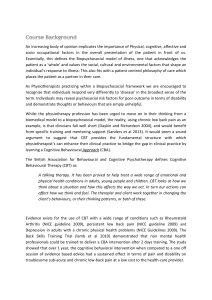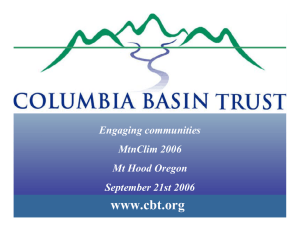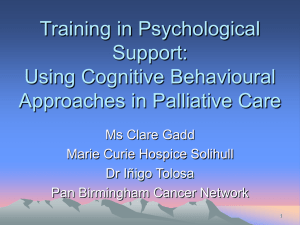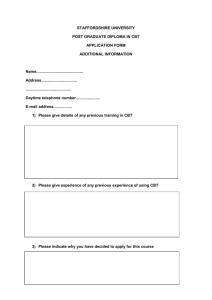Pesky Gnats Adapting CBT for Children
advertisement
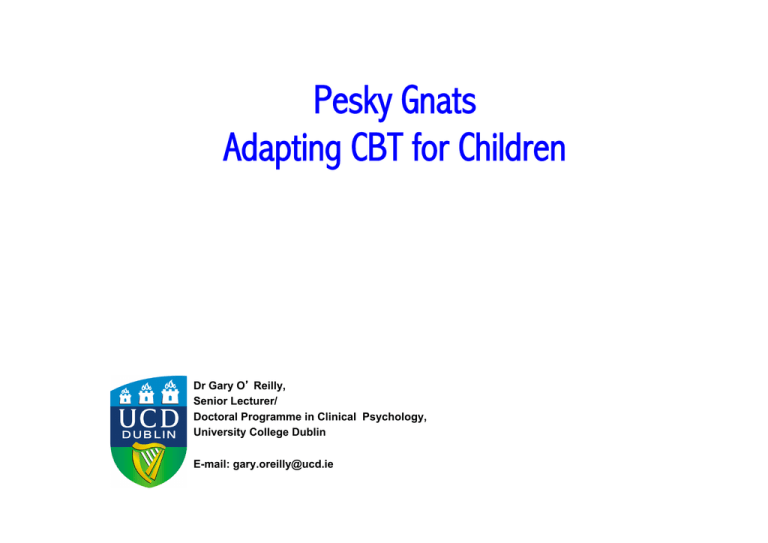
Pesky Gnats Adapting CBT for Children Dr Gary O’ Reilly, Senior Lecturer/ Doctoral Programme in Clinical Psychology, University College Dublin E-mail: gary.oreilly@ucd.ie Pesky Gnats Challenges in adapting CBT for young people • How we are using a computer game to translate CBT into user friendly format for young people • Demonstration of our CBT Computer game for children • Evidence so far • Future directions – Utility of programmes like pesky gnats for wide-scale dissemination of CBT? Since CBT works with adults it is a good candidate for an evidenced based intervention for children and adolescents Disorder Absolute efficacy Relative to medication Relative to other psychotherapy Depression Yes Yes Mixed evidence General anxiety Yes Yes Better Anorexia nervosa Yes Yes Equivalent Schizophrenia OCD Chronic PTSD Chronic Pain Somatic difficulties Substance abuse Yes Yes Used in combination Insufficient evidence Better Better Yes Insufficient evidence Equivalent Yes Insufficient evidence Mixed evidence Yes Yes Yes Yes Insufficient evidence Equivalent Dozois, D. & Beck, A. (2011) Cognitive therapy. In J. D. Herbert, & E. M. Forman (eds). Acceptance and Mindfulness in Cognitive Behaviour Therapy. Understanding and Applying the New Therapies. New York: Wiley. The Cognitive Behavioural Model SITUATION THINKING… Yipee! It’s the weekend no more work after today… I’m at work in my office… FEELINGS… BEHAVIOUR… I leave work with a hop, skip & a jump… Great happiness & Joy! The Cognitive Behavioural Model SITUATION: NEGATIVE AUTOMATIC THINKING… Uh-Hooo I think I’m boring these people with me rubbish talk… I’m at work giving a talk to a bunch of brainy people… PROBLEMATIC BEHAVIOUR… Stumble & stutter & deliver the rest of my talk poorly… OVERWHELMING FEELINGS… Anxiety!!! Key theoretical ideas in CBT… Another key idea in CBT is that our many and frequent negative automatic thoughts share underlying schemata we hold about ourselves referred to as Core Beliefs…. Negative Automatic Thought Level 1: Surface Level Cognition Negative Automatic Thought Negative Automatic Thought Negative Automatic Thought Negative Automatic Thought Negative Automatic Thought Behaviours, Behaviours, Behaviours… Feelings, Feelings, Feelings… Selective Attention Level 2: Intermediate Cognitive Processes and Beliefs Biased Memory Processing Interpretation of neutral or ambiguous events Attitudes & Beliefs Level 3: Deeper Organising Schema: “a well organised cognitive structure of stored information and Cognitive Information memories that forms the basis of CORE BELIEFS about self” (Dozois & Abstracted from Experience Beck 2011; p.27) Dozois, D. & Beck, A. (2011) Cognitive therapy. In J. D. Herbert, & E. M. Forman (eds). Acceptance and Mindfulness in Cognitive Behaviour Therapy. Understanding and Applying the New Therapies. New York: Wiley. Central ingredients in most CBT based interventions include… • • • • • • • • • Psycho-education and problem formulation of specific disorder Monitoring of thoughts, feelings and behaviour Identification, challenging and testing of cognitions Developing new cognitive skills Discovering core beliefs Learning new ways to manage anxiety or unpleasant emotions Learning new behaviours Target setting and home-based practice assignments Positive reinforcement In essence CBT is a complicated adult oriented individual therapy based on meta-cognitive tasks! Its not at all child friendly… Stallard, P (2002; p.11). Think Good Feel Good: A Cognitive Behavioural Therapy Workbook for Children and Young People. New York: Wiley Developmentally when are children ready? Jean Piaget. Developed a staged theory of cognitive development. CBT is like “Formal Operational” thinking so children about 12 yrs + should benefit… Lev Vygotsky. Children have a zone of proximal development so with the right scaffolding younger children can achieve cognitive tasks beyond those of their current completed developmental stage: Children younger than 12 might benefit from CBT… Margaret Donaldson. Piaget missed the specific scaffolding offered by the social context of children’s thinking: Children younger than 12 might benefit from CBT…… 4 simple ingredients in our translation of cbt for children 1. An unfolding concrete metaphor for CBT ideas: Negative Automatic Thoughts (NATs) are described as being like gNATs or little flies that sting you into certain thoughts usually without you noticing. Thought Monitoring becomes gNAT trapping. Cognitive Restructuring becomes gNAT swatting. Understanding Core Beliefs becomes hunting gNATs back to their hives. 4 simple ingredients in our translation of cbt for children 2. We embedded these ideas in a socially meaningful story: In our programme the child plays a computer game where they control a character who represents them on a visit to an island where they help a world famous explorer called David gNATenborough and his team of investigators. As the narrative of the game unfolds they learn about themselves, gNAT trapping, gNAT swatting, and tracing gNATs back to their hive by helping with experiments devised by David gNATenbourough and his team in the world’s first gNAT lab. 4 simple ingredients in our translation of cbt for children 3. Providing an adult to help: In our programme children play the game over the course of 6 appointments side by side with a suitably qualified mental health professional who understands CBT (such as a clinical psychologist, child therapist, child psychiatrist, therapeutic social worker etc). Characters in the game ask questions and set tasks that the young person responds to with the help of their therapist. This is a unique feature of our programme. 4. An environment where children feel at home: Do you know many children who don’t like computer games? David Gnatenborough’s Island by Gary O’ Reilly, Nicola McGlade & David Coyle A 6 session computerised CBT programme that the young person plays in session with their therapist July 2009 Age range 9-13 Internalising disorders O’ Reilly, G., McGlade, N., & Coyle, D., (2009). David Gnatenborough’s Island. A Computerised Cognitive Behavioural Therapy Programme for Children & Adolescents. Version 1.0 The therapeutic space between client & therapist Therapist Client O’ Reilly, G., McGlade, N., & Coyle, D., (2009). David Gnatenborough’s Island. A Computerised Cognitive Behavioural Therapy Programme for Children & Adolescents. Version 1.0 David Gnatenborough’s Island by Gary O’ Reilly, Nicola McGlade & David Coyle O’ Reilly, G., McGlade, N., & Coyle, D., (2009). David Gnatenborough’s Island. A Computerised Cognitive Behavioural Therapy Programme for Children & Adolescents. Version 1.0 David Gnatenborough’s Island by Gary O’ Reilly, Nicola McGlade & David Coyle Every session proceeds with review, introduce cbt skill, example from another young person called Shona, do an example with your therapist, practice outside the session Session One: Meet David Gnatenbourough, learn about the gNAT lab, and meet Prof Alannah Karr who teaches you that thoughts, feelings and behaviours go together O’ Reilly, G., McGlade, N., & Coyle, D., (2009). David Gnatenborough’s Island. A Computerised Cognitive Behavioural Therapy Programme for Children & Adolescents. Version 1.0 David Gnatenborough’s Island by Gary O’ Reilly, Nicola McGlade & David Coyle Session Two: Meet Scott Livingstone, an explorer who is an expert on catching footage of gNATs. Teaches the young person how to set a gNAT trap…aka Thought Monitoring O’ Reilly, G., McGlade, N., & Coyle, D., (2009). David Gnatenborough’s Island. A Computerised Cognitive Behavioural Therapy Programme for Children & Adolescents. Version 1.0 David Gnatenborough’s Island by Gary O’ Reilly, Nicola McGlade & David Coyle Session Three: Meet Shona, a young person who is a former visitor to the gNAT lab Learn how to swat gNATs…aka cognitive restructuring Learn how to relax and receive your own relaxation CD/MP3 file O’ Reilly, G., McGlade, N., & Coyle, D., (2009). David Gnatenborough’s Island. A Computerised Cognitive Behavioural Therapy Programme for Children & Adolescents. Version 1.0 David Gnatenborough’s Island by Gary O’ Reilly, Nicola McGlade & David Coyle Session Four: Meet Sarah, a scientist working in the gNAT lab. Learn how gNATs come from Hives…aka Core Beliefs and how to gather your gNATs into their Hives. O’ Reilly, G., McGlade, N., & Coyle, D., (2009). David Gnatenborough’s Island. A Computerised Cognitive Behavioural Therapy Programme for Children & Adolescents. Version 1.0 David Gnatenborough’s Island by Gary O’ Reilly, Nicola McGlade & David Coyle Sessions Five & Six: Work with David Gnatenborough outside the gNAT lab to challenge and change your Core Beliefs Learn how to evaluate and change your Core Beliefs O’ Reilly, G., McGlade, N., & Coyle, D., (2009). David Gnatenborough’s Island. A Computerised Cognitive Behavioural Therapy Programme for Children & Adolescents. Version 1.0 No charge for any of our materials The game Installation CD Relaxation CD Child’s Manual O’ Reilly, G., McGlade, N., & Coyle, D., (2009). David Gnatenborough’s Island. A Computerised Cognitive Behavioural Therapy Programme for Children & Adolescents. Version 1.0 Do mental health professionals like Pesky Gnats? Ratings of 941 mental health professionals from Ireland, UK & USA of their overall impression of cCBT game Pesky Gnats Key point! 95.6% of mental health professionals from 3 countries rate Pesky Gnats as “above average” or “excellent” Does Pesky Gnats add or subtract from the quality of the therapeutic process with children? Quality of therapeutic relationship – 16 Pesky Gnats V 13 TAU young people 9-16 yrs attending a Health Service Executive child mental health setting Ryan, A., O’ Reilly, G., Coyle, D. & Delahunty, A. (2013). A Pilot-Study of a Computer-Assisted CBT Game in a Chid and Adolescent Mental Health Setting. School of Psychology; University College Dublin Does Pesky Gnats improve the mental health status of children with internalising disorders? Parent Report (CBCL) Internalising Scores – 16 Pesky Gnats V 13 TAU young people 9-16 yrs attending a Health Service Executive child mental health setting Clinical Range Borderline Range Normal Range F values: group = 1.14; time = 31.98 ***; group x time = 2.54 Ryan, A., O’ Reilly, G., Coyle, D. & Delahunty, A. (2013). A Pilot-Study of a Computer-Assisted CBT Game in a Chid and Adolescent Mental Health Setting. School of Psychology; University College Dublin Young Person Self Report (YSR) Internalising Scores – 16 Pesky Gnats V 13 TAU young people 9-17 yrs in a attending a Health Service Executive child mental health setting Clinical Range Borderline Range Normal Range F values: group = 0.40; time = 12.12 ** ; group x time = 0.54 Ryan, A., O’ Reilly, G., Coyle, D. & Delahunty, A. (2013). A Pilot-Study of a Computer-Assisted CBT Game in a Chid and Adolescent Mental Health Setting. School of Psychology; University College Dublin Child self rating of outcome– 16 Pesky Gnats V 13 TAU young people 9-16 yrs attending a Health Service Executive child mental health setting t values: Me= 2.32* ; Family= 2.06* ; School = 2.06 *; Everything = 2.11* Ryan, A., O’ Reilly, G., Coyle, D. & Delahunty, A. (2013). A Pilot-Study of a Computer-Assisted CBT Game in a Chid and Adolescent Mental Health Setting. School of Psychology; University College Dublin Theme Less worry Comment “I don’t worry about as many things” “About finding out my core belief and now I don’t worry as much” I’m not as anxious” More positive “I can think more positive” “I am more positive and better armed to deal with my depression” More confident “I am more confident in swatting gNATs” Feeling better “I am getting better” McGlade, N. (2010). An Exploration of a Computer-Assisted CBT Game and a Measure of Automatic Thoughts In Adolescents. Unpublished Doctoral Thesis: School of Psychology; University College Dublin Does Pesky Gnats have potential for use in non-clinical settings such as schools? CBCL & YSR Internalising Scores – 18 (10 boys 8 girls) young people 9-17 yrs (mean age 11.8) who played Pesky Gnats with a School Psychologist CBCL YSR Clinical Range Borderline Range Normal Range CBCL n =18 YSR n = 10 t values: CBCL = 3.95*** ; YSR = 3.21** O’ Dwyer-O’ Brien, A., O’ Reilly, G., Coyle, S. & Coyle, D. (2012). A Pilot-Study of a Computer-Assisted CBT Game in an Educational Psychology Setting. School of Psychology; University College Dublin Our budget to-date… 0 Euro 0 cent What’s Next…? Revised Version: Pesky Gnats 2! Additional adaptation of technology The Future Development of online training A range of games tailored for children with different needs and adults with an ID Pesky Gnats 2 Pesky Gnats 2 Pesky Gnats 2 Pesky Gnats 2 Pesky Gnats 2! We are embedding standardised measures into the game. 1. To assess symptoms of Anxiety and Depression… Revised Children’s Anxiety and Depression Scale (RCADS) 2. To assess how things are going for the young person at the start of every session… Child Outcome Rating Scale (CORS - for every player 12 and under) and the Outcome Rating Scale (ORS - for every player 13 and older) 3. To assess how each session went at the end of every session using the Child Session Rating Scale (CSRS - for every player 12 and under) and the Session Rating Scale (SRS - for every player 13 and older) • • • • How a child scores on these measures will be instantly scored and graphed for the young person and displayed on screen. Each administration displayed will also display previous administrations for previous levels. All measures automatically appear but option to skip can be selected by players. The ratings will build week by week and the outcome always be printable… Integrating Apps O’ Reilly G. & Erkan, Y. (2011). The Pesky Gnats CBT App. Cork, DeCare Systems Ireland. www.PeskyGnats.com A range of games for young people… • Different age ranges and tailor for different regions/countries • Trauma Focused CBT • Children with ASD • Eating Disorders • Adults with an ID Thank you… • • • • • • • • • • Dr Mary Belton Prof Alan Carr Sadhbh Coyle Laura De Burca Alan Delahunty Dr Gavin Doherty Chris Donnelly Yagiz Erkin Eamon Franklin Clare Gormley • • • • • • • • • • Katie Hendrick Muriel Keegan Aisling O’ Dwyer O’ Brien Paul O’ Donoghue Aisling Ryan Jackie Shipp Staff at HSE Galway Staff at NEPS Fredrick Court Conal Tunney and anyone who has tried to help us www.PeskyGnats.com THE END... Contact details for more info or copies of overheads Dr Gary O’ Reilly, Senior Lecturer Doctoral Programme in Clinical Psychology, School of Psychology University College Dublin E-mail: gary.oreilly@ucd.ie
